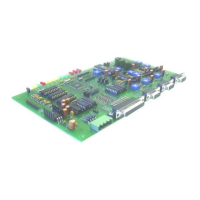Supervisory Commands (continued)
Speech ID Override ON/OFF
Setting the Override to OFF causes user audio to be mixed with ID Speech. Setting the Override to ON causes ID speech to be
stopped if a signal appears on that port's receiver, in which case the voice ID reverts to CW in order to ensure the repeater is properly
identified.
1181 Speech ID Override ON* 2181 Speech ID Override ON* 3181 Speech ID Override ON*
1180 Speech ID Override OFF 2180 Speech ID Override OFF 3180 Speech ID Override OFF
Enable/Disable Port DTMF
Each port may have its DTMF decoder disabled. This function is useful under several circumstances, such as when a user is causing
problems. As a precaution, it is not possible to disable DTMF on the port to which you're currently connected. For example, you must
be using a radio (or repeater) connected to Port 2 or 3 in order to disable DTMF on Port 1.
1161 Port 1 DTMF Enable* 2161 Port 2 DTMF Enable* 3161 Port 3 DTMF Enable*
1160 Port 1 DTMF Disable 2160 Port 2 DTMF Disable 3160 Port 3 DTMF Disable
Require/Not Require CTCSS for DTMF
Each port may be configured to either require a user's signal to contain CTCSS or not require it, in order to enter DTMF commands.
This selection controls DTMF access regardless of the state of the access required for repeater access on that port. In other words, it is
possible to have a port configured for carrier squelch access, yet require CTCSS for DTMF commands to work.
1170 Port 1 no CTCSS for DTMF* 2170 Port 2 no CTCSS for DTMF* 3170 Port 3 no CTCSS for DTMF*
1171 Port 1 CTCSS for DTMF 2171 Port 2 CTCSS for DTMF 3171 Port 3 CTCSS for DTMF
DTMF Evaluation on COS or CTCSS
You may control how evaluation of entered DTMF commands by either COS closure or CTCSS decoder closure.
This can be helpful if your squelch locks open and may be selected on a Port-by-Port basis
1221 Port 1 DTMF Command Evaluation on CTCSS Closure
2221 Port 2 DTMF Command Evaluation on CTCSS Closure
3221 Port 3 DTMF Command Evaluation on CTCSS Closure
1220 Port 1 DTMF Command Evaluation on COS Closure
2220 Port 2 DTMF Command Evaluation on COS Closure
3220 Port 3 DTMF Command Evaluation on COS Closure
Using A Control Receiver
Because of the RC210's ability to control any Port from any other Port, there is no need for a special, dedicated control receiver port. By
using the right combination of Macro Functions, you can easily and quickly disable or enable any function the RC210 is capable of
performing. For example, you have a repeater on Port 1 and a link on Port 2. There is some user randomly entering DTMF, causing
disruption to the users of the repeater. You could "come in" through your link and turn off DTMF on Port 1 by unlocking Port 1 and
entering the command to turn DTMF off. This could be done without your presence being known to the users on Port 1 if you so chose.
You could even use an existing link or repeater as your control receiver and you will still have positive control of your system at all
times. The possibilities are only limited by your imagination and needs of your system.

